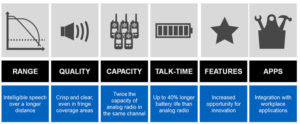Is It Time to Migrate to Digital? Digital Versus Analog Two Way Radios
News | 0 comments | by Vanessa Chavez
Analog two-way radio has been the backbone of two-way radio communications for over a half-century. In recent years, a demand for new features and capabilities that analog technology cannot provide has raised the question for many radio managers of whether it is finally time to begin migrating their systems to digital. While the “digital versus analog” debate will be argued for years to come, the following posts should provide useful information for anyone asking themselves the question: “Is it time to migrate to digital?
Improved voice quality, greater capacity, longer battery life, as well as data features not available on the old analog systems. These are some of the benefits gained with a move to digital. In regard to looming regulatory pressures that demand greater spectrum efficiency to solve the issue of frequency congestion, digital technology provides a good solution to this problem by virtually doubling the channels on a single frequency. Download WHY DIGITAL TWO WAY RADIO WHITEPAPER to learn more.
In this multi-part series on Digital Migration, we cover the topics of Better Range and Voice Quality, Better Capacity, Voice & Data, and Ease of Migration. The chart below shows how digital radios provide greater Range and Voice Quality by leveraging digital technology.
PART ONE: BETTER RANGE AND VOICE QUALITY
All radio signals grow fainter as the user moves toward the edge of coverage. But the voice quality on analog radios degrades much more quickly than on a digital system. At the farther edges of coverage (at comparable signal strength) digital voice quality remains clear and intelligible, where analog voice quality is masked by static and interference making it virtually impossible to understand.
Boosting the signal strength of an analog radio signal can help increase the voice quality at the edge of coverage. This tends to be impractical due to the added battery drain, cross-talk and potential issues with radio power/spectrum regulations. Other analog voice issues can arise when features, such as compounding or voice scrambling for security – are applied to the analog transmission as it often introduces audio artifacts that can degrade the quality of communication.
Since digital radios have built-in error correction to address these issues, voice calls are heard clearly over a greater range with no interference, background noise or distortion and the transmission maintains its voice integrity to the very ends of the coverage area.

